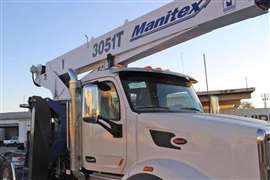Tower cranes in the news at Bauma China
07 January 2025
Construction tower cranes had a strong showing at the Bauma China 2024 show in Shanghai. Alex Dahm was there to report some hightlights.
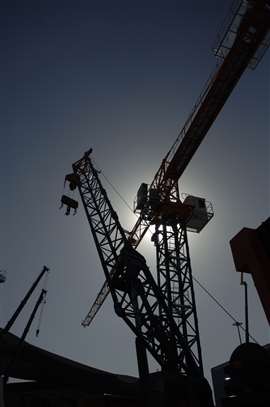 A strong showing of tower cranes, especially mid-range flat tops and larger luffers, some of the latter being hydraulic. Photo: Alex Dahm/KHL Group
A strong showing of tower cranes, especially mid-range flat tops and larger luffers, some of the latter being hydraulic. Photo: Alex Dahm/KHL Group
The Bauma China 2024 trade show held in late November saw a strong showing of new cranes, especially from many of the large number of domestic manufacturers.
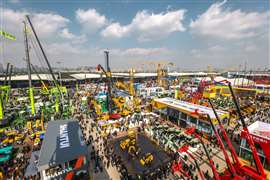 Bauma China 2024. Photo: Bauma
Bauma China 2024. Photo: Bauma
Following on from our report on the mobile cranes at the show, here we concentrate on the construction tower cranes.
They were a strong element of the event in spite or perhaps because of the deep recession in residential construction in China. One domestic manufacturer told ICST sales were down 40 per cent, with the company held afloat only by exports to Russia.
Manufacturers Dahan, Elmak (from Turkey) Huba, Jinnta, Topsky, XCMG and Zoomlion were all present. Liugong which acquired a tower crane manufacturer three years ago was exhibiting them under the Join Hands brand.
Yongmao was present with hospitality, not cranes. This was the same for Liebherr and Manitowoc, the latter using its interactive display stand for the launch of its largest flat top tower crane for the Asian market.
The new Potain MCT 2205 M80 is an 80 tonne capacity, 80 metre jib model built in the Zhanjiagang plant in China. On its standard tower a freestanding height of 71 metres can be achieved while on the two-size combination mast 99.9 metres can be reached. Its entire slewing section, including 11 sections of jib, can be transported in 16 trailers or containers, Manitowoc said.
Two options are available for the counter jib, according to application. One is the full 25.2 metres long and there is 20.2 metre one for more congested job sites. The two types of counterweight options are concrete or steel and concrete, again helping in restricted spaces.
 Nabil Al Zahlawi, NFT CEO and managing partner, right of photo, signed an order for eight units of the new Potain MCT 2205 M80 flat top tower crane. Photo: Manitowoc/Potain
Nabil Al Zahlawi, NFT CEO and managing partner, right of photo, signed an order for eight units of the new Potain MCT 2205 M80 flat top tower crane. Photo: Manitowoc/Potain
New deal
Also during the Bauma China show, a deal was signed for the first units of this new model. Nabil Al Zahlawi, NFT CEO and managing partner, signed an order for eight units, to go on the Trojena tourist resort construction project in the mountains of Tabuk Province in Saudi Arabia. They will have a hook height of 94 metres.
Other applications for this new large Potain flat top tower crane could include construction of waste to energy power plants, data centres and maybe working precast concrete yards. Tip load on the 80 metre maximum jib is 23.5 tonnes.
Another new biggest flat top tower crane model on show (just the slewing section) was the 100 tonne capacity, 2,300 tonne-metre-rated, T80230-100 from Huba. Tip load at the end of its maximum 83 metre jib (78 metres radius) is 23 tonnes. It will lift 48 tonnes at 48 metres radius. Maximum freestanding height on the 3.2 x 3.2 metre mast is 63 metres. Its 170 kW hoist motor can lift a 20 tonne load on two falls of rope at up to 38.6 metres a minute or, on four falls, a 22 tonne load at up to 29 metres a minute. Counter jib radius is 25.2 metres.
Potential applications for this new giant model from Huba were given as government construction companies using them for nuclear power station construction, bridge building and other large projects.
For these heavy applications Chinese manufacturer Yongmao reported that the domestic market is picking up, for example, in power plant construction where cranes of 64 tonnes and upwards, both flat top and luffing jib types, are needed.
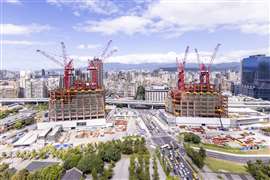 Eight 64 tonne capacity Yongmao luffers on the Taipei Twin Tower project, soon to be joined by a 50 tonner. Photo: Yongmao
Eight 64 tonne capacity Yongmao luffers on the Taipei Twin Tower project, soon to be joined by a 50 tonner. Photo: Yongmao
Big cranes are needed for high rises too. Yongmao has eight 64 tonne luffers on the Taipei Twin Tower project. They are six units of the STL 1600 and two units of the STL 14000D. In March the ninth and final crane, a 50 tonne STL 1000, will be erected on this three or four year job.
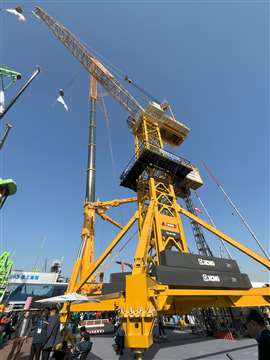 The big XCMG model XGL900-65S luffing jib tower crane. Photo: Alex Dahm/KHL Group
The big XCMG model XGL900-65S luffing jib tower crane. Photo: Alex Dahm/KHL Group
A big luffer in this category on show was the 65 tonne capacity XGL900-65S from Chinese manufacturer XCMG. It is a 900 tonne-metre-rated model with 70 metre maximum radius where it lifts 6.5 tonnes. The rear tail swing radius is given as 9 metres.
On show
Back to flat tops at the show Huba offers a range of around a dozen models, starting at 8 tonnes capacity. It also offers some conventional cat head type towers up to 25 tonnes, and luffing jib models up to 25 tonnes. Its general focus now is on larger models, of 10 tonnes capacity and greater.
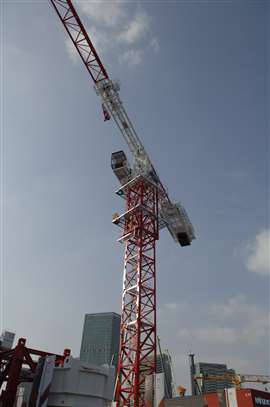 12 tonne capacity Huba T7025-12 flat top tower crane. Photo: Alex Dahm/KHL Group
12 tonne capacity Huba T7025-12 flat top tower crane. Photo: Alex Dahm/KHL Group
Erected at the show was the 250 tonne-metre, 12 tonne capacity, Huba T7025-12 flat top with 70 metre maximum jib, 2,5 tonne tip load and 60.7 metre maximum freestanding height. It has a 65 kW hoist winch.
In China flat top tower cranes are the most popular type and the largest luffers Huba says it really sells in China are 12 tonners. Most of its customers in China are rental companies. Huba said it makes around 1,000 tower cranes in a good year and that it is one of the top ten manufacturers in China.
Huba is actively seeking to expand its distribution network around the world. Countries where it has already sold flat top and hammerhead cranes include India, Pakistan, Korea, Russia, Colombia and the United Arab Emirates. Dealers have been appointed for these last two places. No luffers have been exported yet.
As a sort of typical example of flat top towers on show, Chinese manufacturer Jinnta showed its QTPB250 (C7026P-12). It is a 12 tonner that will free stand to 60 metres on a 2 x 2 metre mast. On two falls of rope its maximum hoist speed is 96 metres a minute.
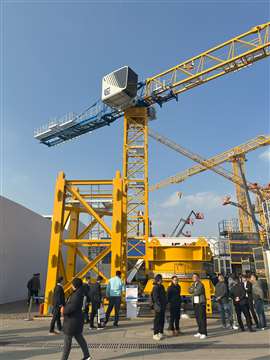 LiuGong’s PT7025A-12 mid-range flat top and the slewing platform and tower section from the JHD660A-50 luffer which lifts 50 tonnes. Photo: Alex Dahm/KHL Group
LiuGong’s PT7025A-12 mid-range flat top and the slewing platform and tower section from the JHD660A-50 luffer which lifts 50 tonnes. Photo: Alex Dahm/KHL Group
A new one on me was that LiuGong makes tower cranes. I missed the last Bauma China. Three years ago the company, which used to make truck and crawler cranes as well as the general construction machinery, acquired a Chinese tower crane manufacturer, branded Join Hands. Since then, as far as cranes goes, it switched to just offering tower cranes.
In its flat top range LiuGong offers models a dozen models from 6 tonnes up to 32 tonnes capacity. On show erected at the 2024 Bauma China was the mid-range PT7025A-12. Capacity is 12 tonnes and at the end of the 70 metre maximum jib it lifts 2.55 tonnes. Maximum freestanding height is 60 metres.
A pattern may be emerging here but, in a different vein and also on display, was the slewing platform and one tower section from Liugong’s biggest luffing jib model in the six-unit range. The JHD660A-50 lifts 50 tonnes and has a maximum 60 metre jib at the end of which the capacity is 9.59 tonnes. Maximum freestanding tower height is 60 metres.
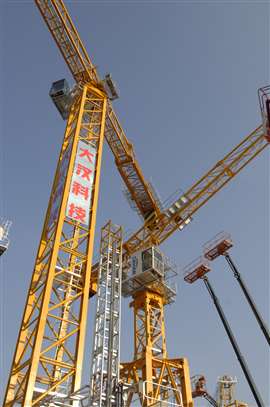 Dahan flat top, pictured with the 45 tonne (on three falls of rope) D6090 hydraulic luffer. Photo: Alex Dahm/KHL Group
Dahan flat top, pictured with the 45 tonne (on three falls of rope) D6090 hydraulic luffer. Photo: Alex Dahm/KHL Group
Chinese manufacturer Dahan also showed two cranes, a flat top and a luffer. The DH620 8530 flat top is available in 25 and 32 tonne versions. It has a jib up to 80 metres, adjustable in 5 metre increments from 30 metres. Maximum freestanding height on the 2.25 x 2.25 metre mast is 67.6 metres. The 32 tonne version has a 110 kW winch while for the 25 tonner it is 90 kW. Both can carry more than 800 metres of hoist rope.
45 tonne hydraulic luffer
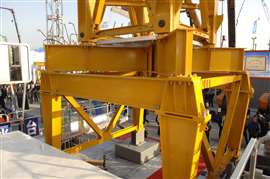 Big stepped tower adaptor, cross type base and portal on the Dahan hydraulic luffer. Photo: Alex Dahm/KHL Group
Big stepped tower adaptor, cross type base and portal on the Dahan hydraulic luffer. Photo: Alex Dahm/KHL Group
The other Dahan tower crane on show was the 45 tonne (on three falls of rope) D6090 hydraulic luffer. Its lifting chart shows a capacity of 12 tonnes at 50 metres.
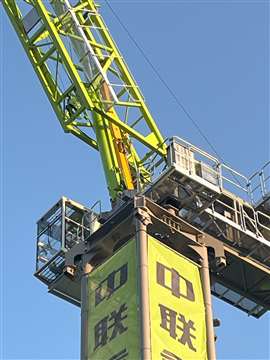 Zoomlion showed one tower crane, its RL205-10/12 combined hydraulic flat top luffing jib model. It was displayed in luffing mode. Photo: Alex Dahm/KHL Group
Zoomlion showed one tower crane, its RL205-10/12 combined hydraulic flat top luffing jib model. It was displayed in luffing mode. Photo: Alex Dahm/KHL Group
Another hydraulic luffer, albeit somewhat different, was on show from Zoomlion. Its one tower crane shown in the iron was the RL205-10/12, a combined hydraulic flat top luffing jib model with a jib up to 55 metres.
This 200 tonne-metre model lifts 12 tonnes and is aimed at very small sites where slewing space is restricted. In luffing rather than flat top mode, its minimum out of service radius is 10 metres.
Topsky showed its TL 430 (TL6055-26) luffer. It is a 26 tonne model with 60 metre maximum jib and a tip load of 5.5 tonnes. Maximum freestanding height for this 480 tonne-metre model is 66.5 metres.
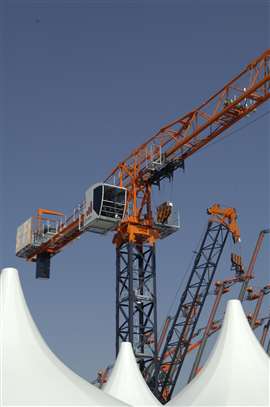 The 10 tonne capacity Elmak ETT6518-10 flat top tower crane. Photo: Alex Dahm/KHL Group
The 10 tonne capacity Elmak ETT6518-10 flat top tower crane. Photo: Alex Dahm/KHL Group
Turkey-based tower crane manufacturer Elmak showed two cranes, the ETT6518-10 flat top and a combination tower crane and derrick crane. The 10 tonne (to 14.8 metres radius) flat top has a maximum 65 metre jib and a tip load of 1.8 tonnes. Maximum freestanding height is 60 metres on a 2.0 x 2.0 metre mast.
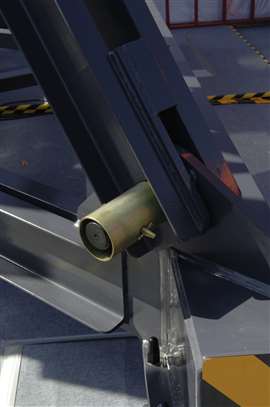 Nice details on the Elmak cranes. Note the radii on the corners of the channel sections and elsewhere throughout. Benefits include inflicting less pain and injury, a neater appearance and the paint stays on better. Photo: Alex Dahm/KHL Group
Nice details on the Elmak cranes. Note the radii on the corners of the channel sections and elsewhere throughout. Benefits include inflicting less pain and injury, a neater appearance and the paint stays on better. Photo: Alex Dahm/KHL Group
The Elmak EMD100-16 derrick crane can be used as a construction crane, mounted on a mast, or as a dismantling derrick crane on the roof of a building. Its luffing jib lifts its 16 tonne maximum out to a radius of 9 metres. Capacity at the full 30.3 metres radius is 3.2 tonnes. It is a containerised crane that also breaks down into sections small enough to fit in a lift.
For news on the mobile cranes at Bauma China 2024 see the first part of this report.



